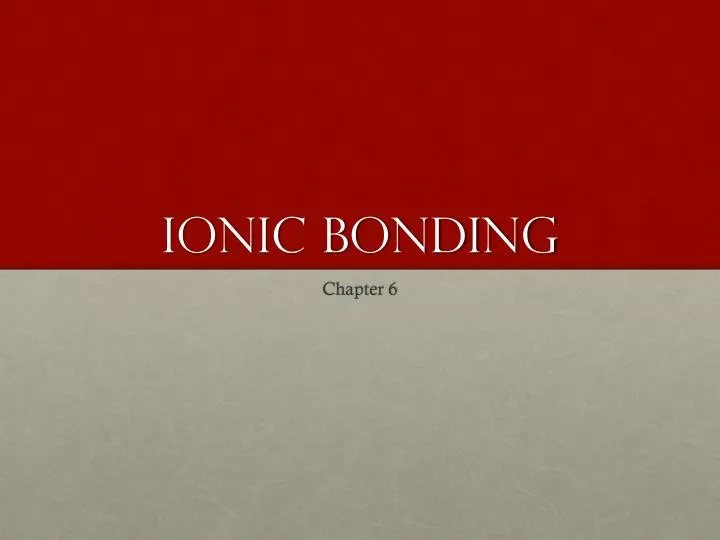How To Draw An Ionic Bond
![]() Download
Download

Skip this Video
Loading SlideShow in v Seconds..
Ionic Bonding PowerPoint Presentation


Ionic Bonding
Download Presentation
Ionic Bonding
- - - - - - - - - - - - - - - - - - - - - - - - - - - E N D - - - - - - - - - - - - - - - - - - - - - - - - - - -
Presentation Transcript
-
Ionic Bonding Chapter 6
-
Quick Review • Atomic number = Total number of electrons • The grouping number tells you the amount of valence electrons an chemical element has. • The metals are on the left side of the periodic table • The nonmetals are on the right side of the periodic table. • All elements need viii electrons in their outer trounce to be stable. (Except H and He, they but demand ii)
-
Valence Electrons • Valence Electron- Whatever electron that is in the outermost energy level of an atom. • When the outer virtually (highest) energy level is full the cantlet is stable. Information technology will most likely not react • What family (group) is least reactive? Why?
-
How many valence electrons? • List the number of valence electrons for the following elements: • i. Potassium__________________ • 2. Silicon ____________________ • 3. Oxygen____________________ • iv. Boron______________________ • 5. Helium_____________________
-
Electron Dot Diagrams • Also called Lewis Structures • The "dots" represent the valence electrons • Element symbol represents the nucleusand inner electrons
-
Steps for drawing dot diagrams • 1. Figure out the number of valence electrons by looking at the periodic tabular array. • two. Write the element symbol • three. Put the dots around the symbol (dots= valence electrons) * start at the top and work clockwise just like the Bohr cantlet models. • ** Remember: each space must be filed with 1 electron before they tin can double up.
-
Examples • Calcium • Sulfur • Neon • Recall the Rules • 1. Figure out the number of valence electrons by looking at the periodic table. • two. Write the chemical element symbol • 3. Put the dots around the symbol (dots= valence electrons) * start at the acme and work clockwise only like the Bohr cantlet models. • ** Retrieve: each space must be filed with i electron before they can double up.
-
Ion Formation • Elements that do not have a full outer shell react with other elements to become more stable. • OCTET Dominion- atoms desire 8 valence electrons in their outermost free energy level • Elements follow this rule by losing or gaining valence electrons (donating or accepting electrons) • When this happens the number of protons and electrons are Non EQUAL anymore. Atoms are no longer overall neutral.
-
ion • Ion- an atom that has a negative or positive charge due to losing or gaining an electron.
-
Lose or gain?
-
H would like to • C would like to • N would like to • O would similar to Proceeds ane electron Proceeds 4 electrons Gain 3 electrons Gain two electrons
-
Ionic Bail • Bond formed between 2 elements by the TRANSFER of electrons • It'due south betwixt a Metal and NONMETAL • Metals= Lose electrons • Nonmetal= Gain electrons • The force that holds ions together.
-
How to draw an ionic bond!!!! • 1. Write out the symbols for the elements you are trying to bail. • two. Describe the Dot Diagram • 3. Determine which element is the metal and which 1 is the nonmetal (Which one is going to lose/proceeds electrons)
-
Drawing ionic bonds • Testify the transfer of electrons using arrows • Na + Cl Na+Cl-
-
one). Ionic bail – electron from Na is transferred to Cl, this causes a charge imbalance in each atom. The Na becomes (Na+) and the Cl becomes (Cl-), charged particles or ions.
-
If an atom loses electrons: • It becomes a positive ion = CATION • These are elements that have 3 or less valence electrons • Elements that have 4 valence electrons can get cations or anions depending on the situation!
-
If an atom gains electrons: • It becomes a negative ion = ANION • To proper name an anion, change the element's proper noun to have "ide" at the cease • These are elements that have 5 or more valence electrons
-
Formation of Ions from Metals • Ionic compounds event when metals react with nonmetals • Metals loseelectrons to proceeds a full outer electron shell (the next electron shell becomes the new outer vanquish) • Positive ionsformwhenelectrons are lost Group 1A metals ion +i Grouping 2A metals ion +ii Group 3A metals ion +3
-
Formation of Ions from Nonmetals • Nonmetals gain electrons to gain a full outer electron shell • Negative ionsformwhenelectrons are gained Group 5A nonmetals ion -3 Group 6A nonmetals ion -2 Group 7A nonmetals ion -1 • Grouping 8A elements do not proceeds or lose electrons since they already have a total outer beat out.
-
The germination of sodium chloride (salt)
-
Properties of Ionic Compounds • Private atoms are leap tightly together forming crystal structures • Loftier melting points • Loftier boiling points • Conduct electricity when melted or in solution • Many tin exist dissolved in water
Source: https://www.slideserve.com/alyssa-harrington/ionic-bonding
Posted by: smallhealf1997.blogspot.com


0 Response to "How To Draw An Ionic Bond"
Post a Comment